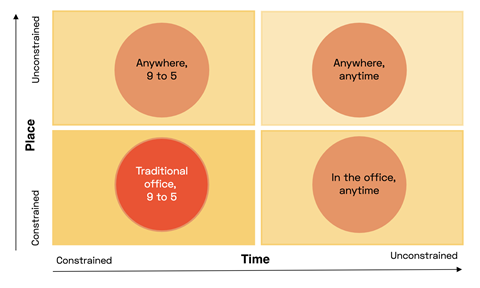Hybrid working poses real challenges for team leaders but there are ways of accommodating staff preferences while also achieving business goals

Those of you of a similar vintage to us might remember the classic Amiga game “Lemmings” in which the player had to guide a group of miniature rodents through a series of increasingly hazardous obstacles to a final haven. Initially the lemmings were compliant, moving together as a herd. But as the game progressed, they developed autonomy and would head off in different directions much to the player’s frustration. Clearly, managing a herd is infinitely easier than attempting to corral a group of individuals with their own paths in mind.

The struggle we faced when playing Lemmings 25 years ago reminds us very clearly of the difficulties faced by the leaders we work with today.
Where once all your people worked alongside each other in the office each day, the pandemic plus changing attitudes towards work and wellbeing mean that leaders must now manage many variables with workers in most knowledge businesses scattered across locations and working hours.
Once, most businesses would have sat firmly in the bottom left quadrant of the grid below. Now though, if we asked each of you reading this article where you would place yourselves in this grid, we would likely get hundreds, if not thousands of data points.

And thanks to a huge cultural shift – both generational and post-pandemic – leaders of site-based businesses are not exempt from this conundrum. While your workers may be constrained in time and place, both recent research and our client experience tell us that their mindset continues to be more focused on personal wellbeing and culture than it was before. This means that whether knowledge or site-based, your workers are evaluating your working culture from a personal wellbeing perspective.
Your workers are evaluating your working culture from a personal wellbeing perspective
Culture is now the key driver of retention, as well as hugely impacting productivity. A recent Gallop study found that “pay is important and it must be fair, but two thirds of the reasons why employees left jobs in 2021 were due to issues with engagement and overall wellbeing.” And toxic culture doesn’t just lead to attrition: engagement for those who stay has also been shown to drop by 20% (MIT Sloan, 2021).
Good culture also makes good business sense. In a recent study, McKinsey found that companies with healthy cultures offer three times greater total returns to their shareholders than those whose cultures are negative or toxic (2021).
While the pandemic may have accelerated this shift, the change is also generational and that means it is here to stay. So, what can you do to create the necessary cultural shift? Like any management challenge, a quick google search will unearth plenty of models to help address this cultural problem. At their heart all focus on communication.
To us, successful communication exists on three levels: enabling workers to feel that they are heard, allowing the space and opportunity for colleagues to communicate openly with each other and ensuring that your leaders communicate openly what the organisation stands for and, crucially, follow through with their behaviours.
Changing communication cultures
Whether your organisation is site-based or hybrid – or a combination of both – the challenge remains to create this culture of open communication at all levels, allowing your people to feel valued and heard.
But how? Both site-based and hybrid businesses face challenges when it comes to creating a change in the communication culture of their organisation.
When your people are physically together each day, they see the culture happen in front of them and can model themselves on the behaviour of their leaders. The challenge here is that not all leaders will have the skills, experience or confidence to communicate in a way that allows employees to feel heard, supported and that their personal wellbeing is valued.
Organisations and leaders also need to be empathetic to how their people want to approach their working day
In a hybrid or remote business, on the other hand, the culture remains, to some extent, ‘unseen’. Here then, the challenge is not only to teach leaders to communicate effectively but then to explicitly explain, exemplify and amplify the culture they want to create.
When we’re asked to go into organisations to support in evolving the culture, the first thing we do is listen carefully and opening, with the goal of understanding what employees have to say. This creates trust, of course, but also allows us to set assumptions aside and truly understand what the employees of this specific business need in the context of their organisational goals.
Supporting your leaders and managers to learn to listen more effectively is a good first step to creating this change internally. When you start to actively listen you open yourself up to truly hearing what changes are needed.
Aligning working practices and behaviours with values
Organisations and leaders also need to be empathetic to how their people want to approach their working day. Hybrid or site-based, the key is to design working practices that are sensitive to employees’ individual preferences and mental health needs while also aligning with the organisation’s desired culture and strategic goals.
Examples of how to make this work are myriad, from allowing specific time off in working hours for charitable or other activities (as implemented by the global tech company 3M), days without meetings (investment bank Citi) or time for other activities, no-meeting lunch breaks or designating specific ‘golden’ and ‘head down’ time (Harry’s the leading razor brand). Each of these solutions has been designed after careful listening to employee preferences, aligning these with business imperatives and then implemented, successfully, using a top-down approach.
A great place to start is having a conversation about how your people want to work
If your business could benefit from bridging the gap between the personal preferences of your people and the company culture you want to create, a great place to start is having a conversation about how your people want to work. One of our favourite tools to help leaders have the conversation is this simple set of conversation starters:
We ask each team member to complete this framework independently. Then bring the team together with leaders to explore how individual and team preferences could mesh together as well as considering the needs of the organisation as a whole. A simple, open conversation… as always, its our favourite place to start.

Natalie Hall and Phanella Fine run Up Rising, a human capital consultancy focused on culture and leadership
Every Person Counts

We know the industry has no shortage of suggestions for tackling construction’s skills crisis, from reforming apprenticeships, to offering more flexibility, to increasing diversity, to providing better pathways from education to the workplace. Our Every Person Counts coverage aims to provide a place where debates can play out, views be aired and solutions shared on all these topics.
If you have an employment initiative you want to tell us about email us at newsdesk@building.co.uk with the subject line “Every Person Counts”. You can also contact us via Twitter @BuildingNews and LinkedIn @BuildingMagazine, please use the hashtag #everypersoncounts. We look forward to hearing your employment stories.
You can find all our Every Person Counts coverage in one place on our website.
And if your organisation has a particularly strong record in this area, you could consider entering the Every Person Counts – People Strategy Award at this year’s Building Awards.



























No comments yet